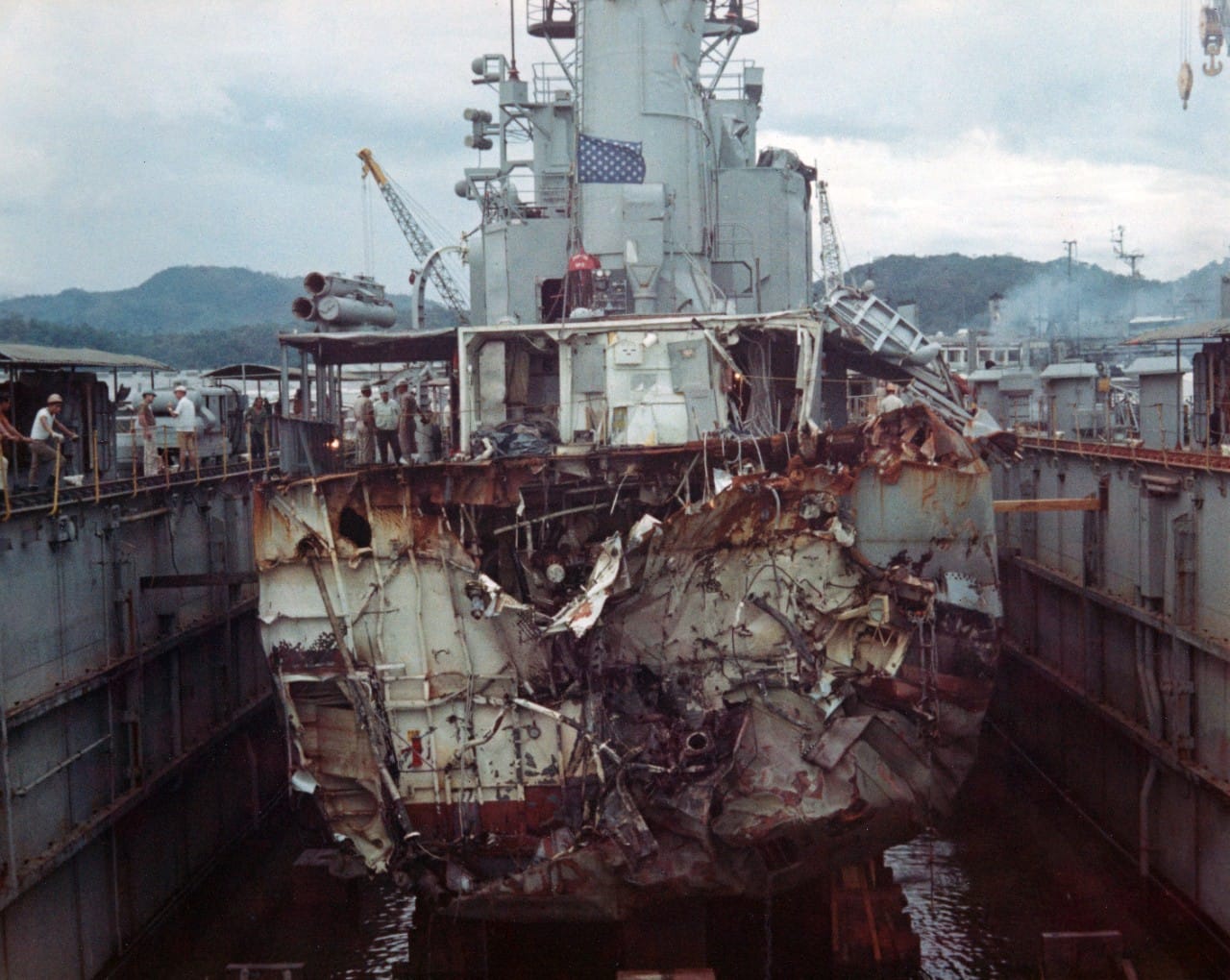Long Beach to honor the ‘Lost 74’
City officials will commemorate the 74 sailors killed on June 3, 1969 on the USS Frank E. Evans, which had been home-ported in Long Beach for nearly two decades.

The sea was glass that night, illuminated under bright moonlight, sailors recalled. It was late spring of 1969 and the American destroyer USS Frank E. Evans, which had been bombarding the coast of South Vietnam just a couple weeks earlier, was steaming in close formation with three other vessels, including the Australian aircraft carrier HMAS Melbourne, as part of multinational training exercises in the South China Sea.
The exercises were going well, until the early morning hours of June 3, when the Melbourne collided with the Evans. The hulking Australian ship knifed into the Evans just aft of the ship’s forward smokestack, quickly slicing the much smaller ship in two.
The impact was so violent that it tossed Signalman Marcus Rodriguez into the air and onto the Melbourne’s flight deck, seriously injuring him, according to the U.S. Naval Institute.
“The impact hurled many men from their racks and others woke up and screamed as they died amid explosions, fire, falling debris, flooding, and severe rolls,” states the official U.S. Navy history of the Evans.
In all, 74 of the 336 American sailors aboard the Evans died that night. All but one of them were trapped in the ship’s forward section. Now detached from the rest of the ship, it rolled over and sank in 6,600 feet of water just nine minutes after the collision, according to the Navy.
Seventy-three bodies were never recovered.
The Navy’s official history states that the dead included three brothers — Gary, Gregory and Kelly Sage — and Lawrence J. Reilly, Jr., whose father was also serving on the Evans but survived.

Next month, on the 56th anniversary of the tragic collision, the city will honor those lost on the Evans in a ceremony at the Shoreline Aquatic Park Navy Memorial. The June 3 ceremony coincides with the renaming of the junction of the 710 freeway and Pacific Coast Highway in honor of the Evans and the Lost 74, according to the city.
“Long Beach has a long and storied naval history, and with this event, we are paying tribute to that history by raising awareness about USS Frank E. Evans and the Lost 74,” Mayor Rex Richardson said in a May 7 news release. “This event offers an important opportunity to tell these stories and to honor our hometown heroes in the beautiful, reflective setting of the Navy Memorial in Shoreline Aquatic Park.”
Steve Kraus knows these stories well. A sailor on the Evans, he had only been aboard a few weeks when the disaster struck. He was on duty that night, standing on the signal bridge near Rodriguez, and said he had no idea what happened to the young sailor until hours after the collision.
“He was in and out of hospitals for about a year,” Kraus said in a May 8 interview with the Watchdog, adding that Rodriguez died in 2020.
Though Kraus had been standing close to Rodriguez at the time of the collision, he said his only injuries were a bruise and a torn fingernail.
Today, Kraus is president of the USS Frank E. Evans Association, which both helps former Evans sailors and does what it can to keep the ship’s history alive.
The recent renaming of the 710/PCH interchange to the "USS Frank E. Evans Lost 74 Memorial Interchange" was a victory for the association, but getting the names of the Evans dead etched on the Vietnam War Memorial in Washington D.C. has proven to be a long, and so far unsuccessful, fight.

Commissioned in early 1945, the USS Frank E. Evans was named for a U.S. Marine general from World War I. The ship served in the Pacific during the final months of World War II, then was decommissioned a few years after the end of the war.
The outbreak of the Korean War in 1950 saw the ship returned to active duty. It was engaged in war patrols and shore bombardment on a number of occasions. Two years later, the ship’s home port changed from San Diego to Long Beach, where the ship would be based for the remainder of its service, according to the Navy.
“Long Beach then was a Navy town, for sure,” Kraus said. “Everyone went to the Pike. Downtown there were tattoo places, bars. It was so similar to San Diego.”
The early 1960s saw the ship appear in the television sit-com "Ensign O’Toole," about hijinks on a fictional destroyer during peacetime.
During the Vietnam War, the Evans participated in multiple shore bombardment operations, the last taking place just a couple weeks prior to the collision with the Melbourne.
On that night, Joe Mulitsch, then 19, was a new fireman aboard the Evans. He’d signed on to the ship four months earlier, according to his oral history, posted on the Frank E. Evans Association’s website.
His bunk was in the aft part of the ship, just beneath the 5 inch gun. As he was finishing work, he was looking forward to shore leave in Thailand in a few days, he said.
When he came off duty, Mulitsch started to climb a ladder when he suddenly felt the ship rise, he recalled. Instantly the lights in the compartment went out as water rushed in. Nearly drowning, Mulitsch said he resigned himself to death just before succeeding in getting his head above water. Then he managed to make his way topside with other sailors, where they were horrified to see the Evans’ bow was now gone.
“Why was I spared when just a few feet away so many of my shipmates died?” Mulitsch asked in his oral history. “Everyone I ate dinner with that night perished.”
After the collision, Navy crews worked furiously to stabilize the Evans’ stern section, which was still afloat. Salvage tugs then towed what was left of the ship to Subic Bay in the Philippines, according to the Navy.
A joint American-Australian board of inquiry convened soon after. It didn’t take them long to conclude that "primary responsibility" for the collision lay with the officers in charge of the Evans, according to the Navy.
The Evans’ commanding officer, who was asleep at the time of the collision, was court-martialed, found guilty of negligence and reprimanded.
The lieutenant who’d been commanding the ship at the time of the accident was also found to have been negligent and reprimanded, the board concluded. He had incorrectly decoded a message from the Melbourne detailing that ship’s exact course, failed to take quick corrective action, even after the Melbourne repeatedly broadcast to them that they were on a “collision course” and failed to follow the captain’s orders to wake him in the event of a course change, according to the Naval Institute.
After inspecting what remained of the Evans, the Navy decided to decommission the ship, stating that repairing it would cost nearly as much as simply buying a new destroyer. In October 1969, the Evans' stern section was sunk as part of a training exercise.
U.S. Navy training film on the loss of the USS Frank E. Evans
Six years later, the U.S. Navy produced a training film on the Evans for junior officers. Titled "I relieve you, Sir," the film methodically explained all the failures on the Evans' bridge prior to the collision to show what ideally should happen when an officer assumes command of a ship.
As for Kraus, he left the Navy in 1970 when his enlistment was up.
“I’m kind of the standard Vietnam Vet of the era,” he said. “It was not a well accepted war, and we didn’t talk about it.”
But in the 1990s, he heard about the Frank E. Evans Association, and began attending reunions. He joined the association in 2004, and became president in 2018.
Though the loss of the Evans took place nearly six decades ago, he said he still thinks about the collision every day. “It’s one of those things you don’t just put away."
The June 3 ceremony will take place at 10 a.m. at the Navy Memorial in Shoreline Aquatic Park (200 Aquarium Way), where memorial markers for the Lost 74 are located. The program will include a presentation about the Evans tragedy, told by a survivor of the collision, and will include a bell-ringing ceremony, a reading of the names of the fallen, a wreath-laying ceremony, a 21-gun salute, and the firing of water cannons by a Long Beach Fire Department fireboat. There will be a free lunch after the ceremony, while supplies last.
We need your support.
Subcribe to the Watchdog today.
The Long Beach Watchdog is owned by journalists, and paid for by readers like you. If independent, local reporting like the story you just read is important to you, support our work by becoming a subscriber.





